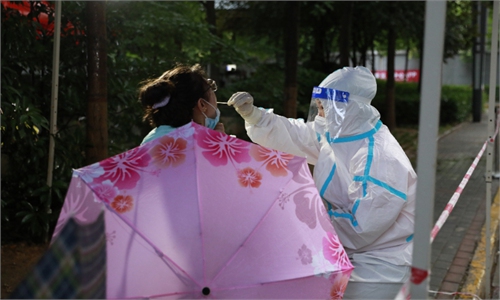Xi’an authorities say temporary prevention conducted in some public places, no city lockdown

Residents fetch take-out food outside an office building in Xi'an, Northwest China's Shaanxi Province, the first day that the city conducts seven-day temporary epidemic prevention control measures in some public areas. Photo: VCG
Authorities in Xi'an, Northwest China's Shaanxi Province, on Tuesday night said that the city would conduct temporary seven-day epidemic prevention control measures in some public places in order to reduce personnel flow and cross-infection risks, but there is no entire city lockdown, as the local health authorities have confirmed that the latest COVID-19 flare-up was caused by the Omicron BA.5 subvariant.
Xi'an on Tuesday registered one local case and 10 asymptomatic cases, according to Shaanxi health commission on Wednesday.
Large commercial and supermarket complexes, convenience stores, farmers' markets and medical institutions closely related to people's lives are operating normally currently, according to Xi'an authorities. Entertainment venues and dine-in services were suspended.
People are free to move in some working places, residential compounds, outdoor tourist attractions and supermarkets under strict COVID-19 preventive measures, according to local authorities.
Samsung's Xi'an facility is now in normal operations, the company told the Global Times on Wednesday.
"We still work normally as our community is at low-risk region, and the surrounding supermarkets and pharmacies are operating normally; but the dine-in services have been suspended," a Xi'an resident surnamed Zhou told the Global Times on Wednesday. Zhou said they can move freely and need to scan a QR code before entering these places.
Since early morning on Wednesday, residents in Xi'an have started to receive nucleic acid tests.
Liu Guozhong, Shaanxi provincial CPC chief, stressed on Tuesday that the key to the current epidemic prevention and control is to work "fast" and run ahead of the virus, according to Shaanxi authorities.
Lu Hongzhou, head of the Third People's Hospital of Shenzhen, said they should "act in a fast way to curb the epidemic."
Compared with the previous BA.1 and BA.2, Omicron subvariant BA.5 has stronger spreading capacity with faster speed, Lu told the Global Times on Wednesday. "Moreover, it has stronger ability to avoid immunity."
BA.5's infection efficiency of human lung tissue cells was higher than that of BA.2, and the pathogenicity in animal model was higher than that in BA.2, but it's milder than the Delta strain, according to Lu.
At present, BA.5 has replaced BA.2 as the most dominant strain worldwide, Lu said.
Lu believes that the seven-day temporary control measures could work well to curb the virus spread based on the previous experiences in other cities such as Shenzhen, as more efficient and precise prevention and control measures are needed to face BA.5.
Except Xi'an, some other places across the country also have seen an epidemic rebound recently such as Shanghai and East China's Anhui Province. In Shanghai, the city reported two new local COVID-19 cases at the community level, with four high-risk and 22 medium-risk regions listed, as the city on Tuesday evening launched an urgent mass nucleic acid testing in several districts after some residents were found linked to a high-risk commercial complex.
In Anhui's Sixian county, 75 confirmed cases and 126 asymptomatic cases were registered Tuesday, according to the local authorities on Wednesday. Sixian county authorities on Wednesday issued a public letter to the residents that the epidemic is under control generally and the positive cases among community level have showed a declining trend after a 10-day fight against the virus.

